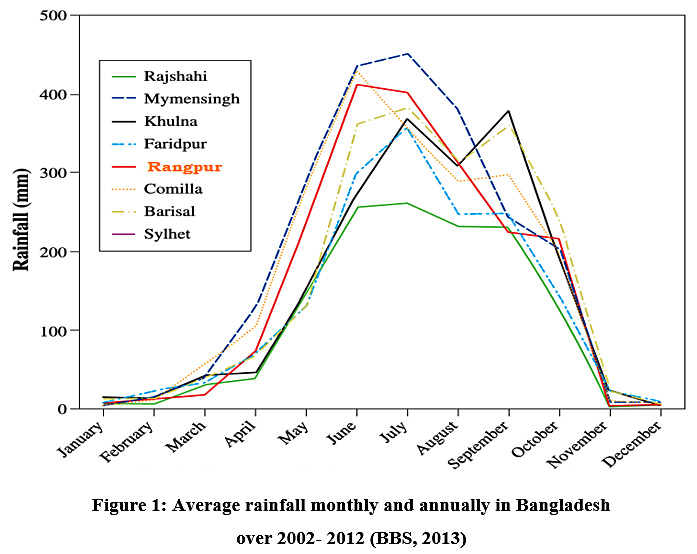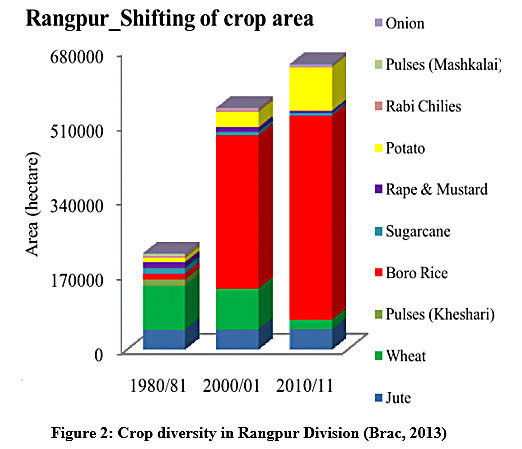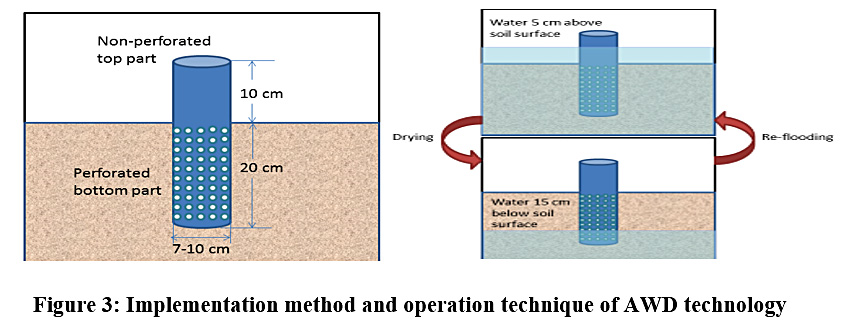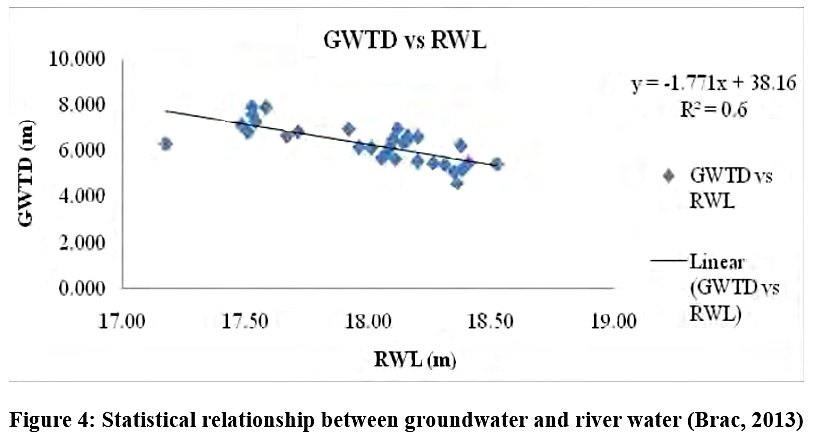Strategic Ground Water Management Planning for Rice Field in Rangpur Division, Bangladesh
1
Soil, Water and Environment Discipline,
Khulna University,
Khulna,
9208
Bangladesh
Corresponding author Email: tareqss_ku@rocketmail.com
DOI: http://dx.doi.org/10.12944/CWE.14.2.16
Copy the following to cite this article:
Salam M. T. B, Zaman S. M. S, Nuralom M, Hossain M. Strategic Ground Water Management Planning for Rice Field in Rangpur Division, Bangladesh. Curr World Environ 2019; 14(2).
DOI:http://dx.doi.org/10.12944/CWE.14.2.16Copy the following to cite this URL:
Salam M. T. B, Zaman S. M. S, Nuralom M, Hossain M. Strategic Ground Water Management Planning for Rice Field in Rangpur Division, Bangladesh. Curr World Environ 2019; 14(2). Available from: https://bit.ly/2U8UtJ9
Download article (pdf) Citation Manager Publish History
Select type of program for download
| Endnote EndNote format (Mac & Win) | |
| Reference Manager Ris format (Win only) | |
| Procite Ris format (Win only) | |
| Medlars Format | |
| RefWorks Format RefWorks format (Mac & Win) | |
| BibTex Format BibTex format (Mac & Win) |
Article Publishing History
| Received: | 2019-07-08 |
|---|---|
| Accepted: | 2019-08-21 |
| Reviewed by: | 
 Dr. Chadetrik Rout
Dr. Chadetrik Rout
|
| Second Review by: |

 Dr. Amit Bera
Dr. Amit Bera
|
| Final Approval by: | Dr Umesh Kulshrestha |
Introduction
Strategic groundwater (GW) management is the continuous planning, monitoring, analysis and assessment of all that is necessary to make the best use of ground water in a sustainable way. Globally, 50% of present drinkable water, 40% of the industrial water demand, and 20% of the irrigation water have been supplied by groundwater (UNESCO, 20031 and Molden, 20072). Rice is covered on 75% of the total cultivated land and is main staple crop in the country, comprising 90% of the total food grain (BADC, 2013).3 Three seasonal rice are available in Bangladesh i.e. Aus, Aman and Boro. Aus are grown in early of rainy season and lower potential where as Aman is grown during the rainy season and is also lower potential of yield. But boro has high yielding potential and grown in dry season (January through June). Due to higher yielding potential, production of boro rice has been prolonged in the last 20 to 30 years (Talukder, 2008).4 During 1991-2013, Prolongation of boro rice augmented from 6.8 to 18.8 million tons whereas the invention of aus and aman largely kept constant (BBS, 2013).5 Boro rice has enthused Bangladesh to boost its total paddy production from 18.3 million tons in 1991 to 33.8 million tons in 2013. The vivid soaring of boro production was only the widespread withdrawal of GW. Now-a-days, almost 80% of GW is utilized for irrigation purposes, where 73% is owned solely by boro growers (Rahman et.al., 2008).6 Rangpur is a very fertile land and most of the delicious rice varieties are grown here like Balam, Katarivog, Najir shail, Pijar, Swarna etc (Brac, 2005).7 Boro rice is particularly dominating and most of the land is irrigated with ground water. Situation is that GW table in the northern region is sequentially fallen down thus creating concern to extend irrigation system in this zone. This study is going to identify six major strategic decisions that are being suggested to sustainable use for groundwater at rice field in Rangpur division of Bangladesh.
Methods
Study Area
The investigated zone was in eight districts of Rangpur Division, Bangladesh (Map 1).
Data Source
By using survey questionnaire, primary data were collected through extensive field visit. From an upazila (sub district), 20 families were selected under three major categories (minor, undersized and middle/outsized) covering all season rice crops from each district. Numbers of total sample were 160 (Eight upazilas) by covering three major farm categories. In each upazila, minor, undersized and middle/outsized farms were 20 in each group. Data were collected once in a cropping season. Secondary data were taken from different research paper and journals and then prepared the final report.
The Physical Context
Bangladesh is the biggest deltas in the world which is surrounded by the alluvium deposition of major rivers in the country (Ganges, Brahmaputra, and Meghna) (Ahmad et.al., 2001).8 In Bangladesh, average precipitation rate varies about 1,200 mm to 4,000 mm depending on areas (Chowdhury, 2010).9 In Rangpur division, most of the precipitation (>80%) occurs during in rainy season in the month of May to August (Fig. 1). In dry season (December–February), minimal amount of precipitation has been received in Rangpur (<20%). Therefore, seasonal water shortage is seen depending on the duration of the monsoon. Production of Rice is one of the most significant activities that help to enrich the economy at Rangpur division. Now almost 80% lands are now being cultivated for rice that have been shifted other crops over the period of time (Fig. 2). During winter, the allocation of fresh water is only 28% that is available for irrigation (Chowdhury, 2010).9 In Rangpur, limitation of surface water availability and the painless access during GW withdrawal by using shallow tube wells (STWs) have stimulated growers to pull out GW for irrigation. Table 1 presented that Rangpur division is one the highest irrigation contributor for STWs and DTWs after Dhaka division (BADC, 2013).3
Table 1: DTWs and STWs status of different division in Bangladesh
|
Divisions |
Deep Tubewells |
Shallow Tubewells |
||
|
Population (No.) |
Area Irrigated (ha) |
Population (No.) |
Area Irrigated (ha) |
|
|
Dhaka |
6918 |
170,088 |
408,767 |
1,054,963 |
|
Rajshahi |
16352 |
467,133 |
348,267 |
713,389 |
|
Rangpur |
6515 |
157,798 |
414,546 |
785,944 |
|
Chattogram |
2329 |
62,720 |
63,047 |
166,268 |
|
Khulna |
3064 |
68,895 |
281,824 |
484,944 |
|
Barishal |
1 |
20 |
45 |
240 |
|
Sylhet |
143 |
7,688 |
6,534 |
36,692 |
|
Total |
35322 |
934,352 |
1,523,609 |
3,242,440 |
(BADC 2013)
 |
Figure 1: Average rainfall monthly and annually in Bangladesh over 2002- 2012 (BBS, 2013) Click here to view Figure |
 |
Figure 2: Crop diversity in Rangpur Division (Brac, 2013) Click here to view Figure |
Case Analysis
Situational and Environmental Analysis Data are presented in Area Map 01.
 |
Map 01: Situational and Environmental Analysis Data on Area Map Click here to view Map |
Strategic Planning (What can be done?)
Depending on situational and environmental analysis following strategic planning can be taken for ground water management.
Strategy 1: Right choice of rice verities
Alter the current cropping system with the crops that are drought tolerant. High yielding rice varieties are more water consuming crops. If drought tolerant rice varieties can be chosen in cropping pattern, the water consumption as well as the pumping of ground water can be minimized in dry season. The most common rice varieties are BRRI Dhan 56, 57, 66 and 71 that are recommended by BRRI10 in late Aman (Monsoon) season which is drought tolerant variety.
Strategy 2: Innovate water saving technology
Tactic 1: Alternate wetting and drying (AWD)
Alternate Wetting and Drying (AWD) is a water-saving technology that farmers can use to implement for maximizing their irrigation water demand in paddy fields without declining its yield (Fig. 3). In AWD, periodic cycle is maintained and been flooded and non-flooded alternately. Depending on soil type, weather or climatic condition and stage of crop growth, the flooding or drying cycle may be varied (1 to 10 days). This method is generally appropriate in low land rice cultivation. Exception is that if rainfall can exceed the evapotranspiration or seepage, therefore, this method cannot be applied thus the method is applicable for dry seasonal rice cultivation. Hasan et.al., (2016),11 Majeed et.al., (2017)12 got the tremendous result by adopting AWD technique as of water saving technique for rice cultivation.
 |
Figure 3: Implementation method and operation technique of AWD technology Click here to view Figure |
Tactic 2: Cut off ratio
Cutoff ratio is decided by the slope of the border and texture of the soil. The inflow stream can be cutoff when it reaches a certain percentage of the total length of the border. The value of the cutoff ratio lies generally in the range of 65 to 80%. Younts (2008) demonstrated a project where he found that clay soil had the best water saving range betweem 0.1 to 3.2 ace-inches with an avarage of 1.4 acre-inches by adopting cutoff ratio. This process was also economical that saved almost $14 per acre.
Strategy 3: Irrigation Scheduling
Scheduling irrigation is a process to apply water for a particular crop on suitable amount in a definite stage for growth and development of that crop. The basic rationales for irrigation scheduling are know the soil moisture, root zone depth, soil water holding capacity, effective precipitation rate and amount of daily water use. In a nutshell, the key factors for managing irrigtion are to find the rate of water that enters into the soil, rate of water that can hold by the soil and the rate of water that is being used by the plants.
Strategy 4: Introduce organic fertilization
Organic fertilization is used to improve soil fertility by increasing soil organic matter content and providing micronutrients and other growth factors not normally supplied by inorganic fertilizers. Shil et.al., (2016)14 stated that the soil organic matter content for different soil series in Rangpur division varied between 1.53 to 1.86%. But this should be at least 5% for ensuring as a good healthy soil. So, application of organic manure not only improves soil fertility but also ensures the protection of ground water.
Strategy 5: Rain water harvesting (RWH)
RWH is a process of collecting and conserving the natural runoff water for reuse in home or paddy field for irrigation purpose. It can also be used for ground water recharge. Though implementation of RWH is very simple in principle, lots of issues arise during implementation like climatic pattern, weather condition, available funds etc. Recharging groundwater aquifers by bore wells, dug wells and pits are the best example of rain water harvesting.
Strategy 6: Reservoir Management
Need to excavate of major rivers and canals like Bramaputra, Atrai, Tista, Dhorola, Dudkumar, Korotoa, Ghaghot, Akhira, Jamunasshori etc because river water flow rate has a significant relationship with GW. Brac, (2013)15 reveals a positive relationship (R =0.6) between declining trend of river water level and groundwater table (Fig. 4). This graph states that GW depleted gradually by depleting river water flow in Teesta river. Teesta is a major river in the studied area that is playing as a major contributor in recharging GW. Since surface water and groundwater are generated from one singular source and interconnected physically in the hydrologic cycle that’s why, reservoir management is necessary to protect GW in Rangpur area.
 |
Figure 4: Statistical relationship between groundwater and river water (Brac, 2013) Click here to view Figure |
Conclusion
Sustainable use of groundwater for irrigation in Rangpur is a matter of concern due to climate change. Over exploitation of GW, soaring of boro cultivation, digging more tubewells, interruption of normal river water flow, plunging of wetland areas, plummeting average rainfall over the year are the key barriers in ensuring sustainability of GW that has been identified through the study. To achieve goal of food security, we have to produce more rice by protecting our ground water resources. So, sustainable technology needs to implement for protection of our future. The study has identified six key strategies that need to adopt in field basis for protecting GW in Rangpur. The study has some limitations like geography and topography analyses are further requirement which is not done here due to finance issue. Hopefully, this study has created a new platform how we can ensure GW sustainability by achieving the objectives of food security at Rangpur in Bangladesh.
Conflict of Interest
The authors declare that they have no conflict of interest.
Acknowledgements
It’s a self funded as well as self initiative work. The authors thank to all local peoples of the studied area as well as government office like Ministry of Agriculture, local weather forecasting office and local NGOs.
References
- UNESCO. The UN World Water Development Report. Retrieved from http://www.unesco.org, 2003.
- Molden D. J. Water for food, water for life: A Comprehensive assessment of water management in agriculture. Earth scan and the International Water Management Institute, London and Colombo, 2007.
- BADC (Bangladesh Agricultural Development Corporation). Minor irrigation survey report 2012-2013. Bangladesh Agricultural Development Corporation, Ministry of Agriculture, Government of Bangladesh, 2013.
- Talukder R. K. “Food security in Bangladesh: National and global perspectives,” In Proceedings BKAS 13th National Conference and Seminar on Climate Changes: Food Security in Bangladesh, Vol. 13, Dhaka, Bangladesh, 2008.
- BBS (Bangladesh Bureau of Statistics). Agricultural Statistics Yearbook. Dhaka, Bangladesh, 2013.
- Rahman M. W, Ahmed R. “Shallow tube well irrigation business in Bangladesh,” Paper Presented at Summary and Synthesis Workshop at Kathmandu, Nepal, March 20–24, 2008.
- Brac. Rice Biodiversity in Bangladesh: Adoption, Diffusion and Disappearance of Varieties. A Statistical Report from Farm Survey, 2005.
- Ahmad, Q. K, Biswas A. K, Rangachari R, Sainju M. M. Ganges–Brahmaputra–Meghna Region: A Framework for Sustainable Development. The University Press, Dhaka, Bangladesh, 2001.
- Chowdhury N. T. Water management in Bangladesh: an analytical review. Water Policy, 2010; 12: 32-51.
- BRRI (Bangladesh Rice Research Institute). Website: http://www.brri.gov.bd/, 2019.
- Hasan K, Abu Habib A, Abdullah M, Bhattacharjee D and Afrad S. I. Impact of Alternate Wetting and Drying Technique on Rice Production in the Drought Prone Areas of Bangladesh, Indian Res. J. Ext. Edu. 2016; 16(1): 101-105.
- Majeed A, Saleem M, Jalil S, Abbas SH and Hayat A. Water Saving Rice Production Using Alternate Wetting and Drying Technique in Rice Based Cropping System in Sindh, Pakistan. Science, Technology and Development 2017; 36(1): 30-35.
- Yonts C. D. Using Cutoff Ratio to Fine-Tune Furrow Irrigations (Save $14/acre). https://cropwatch.unl.edu/using-cutoff-ratio-fine-tune-furrow-irrigations-save-14acre, 2008.
- Shil N. C, Saleque M. A, Islam M. R. and Jahiruddin M. Soil fertility status of some of the intensive crop growing areas under major agro-ecological zones of Bangladesh. Bangladesh J. Agril. Res. 2016; 41(4): 735-757.
CrossRef - Brac. Sustainability of Groundwater Use for Irrigation in Northwest Bangladesh. A report based on survey, 2013.







